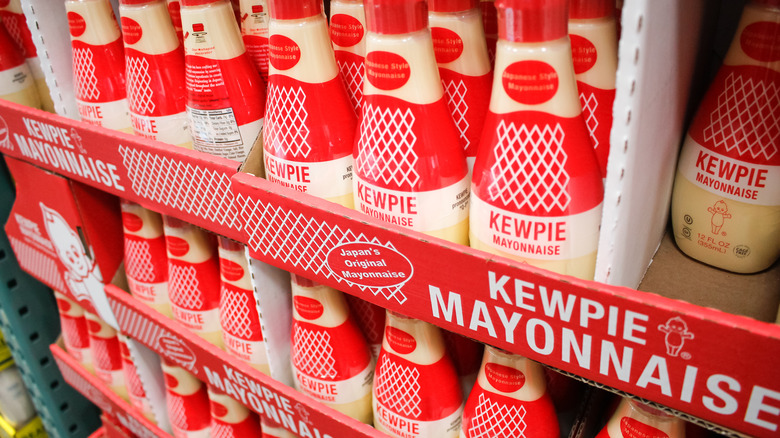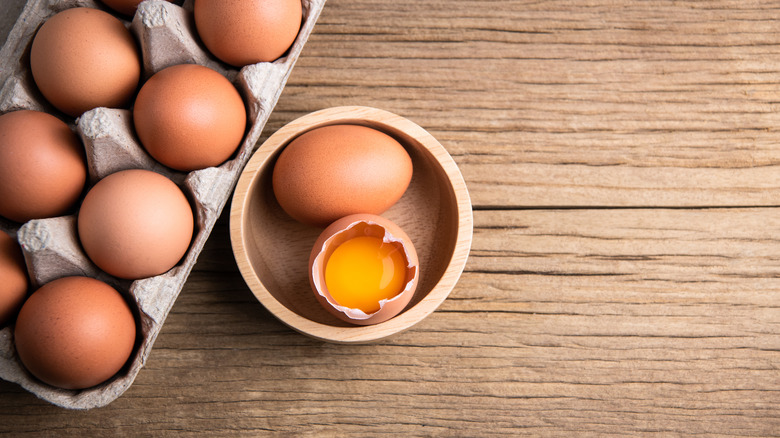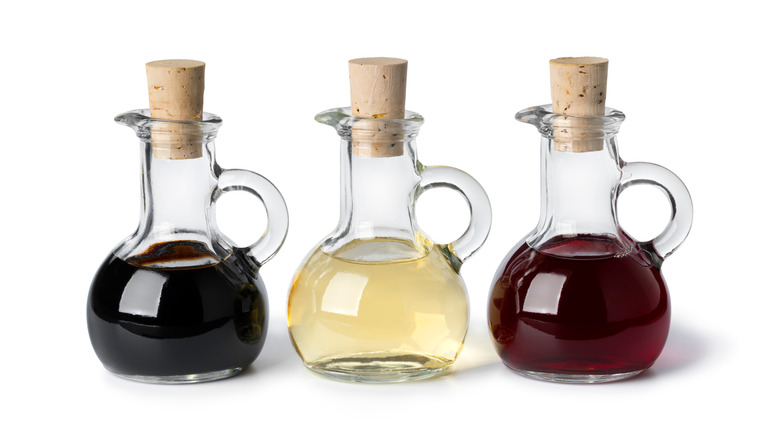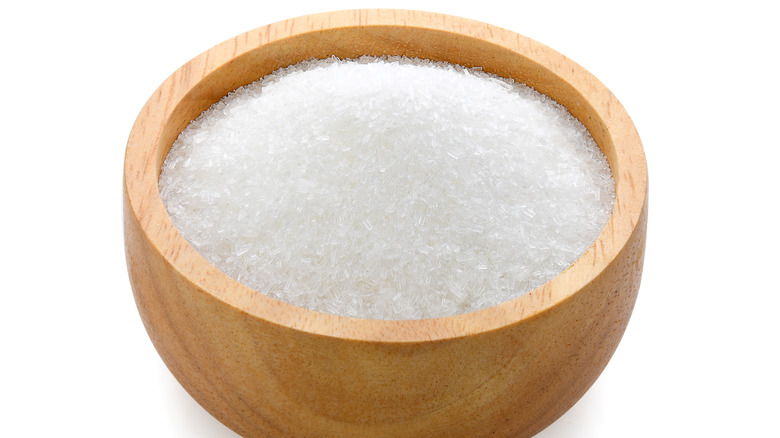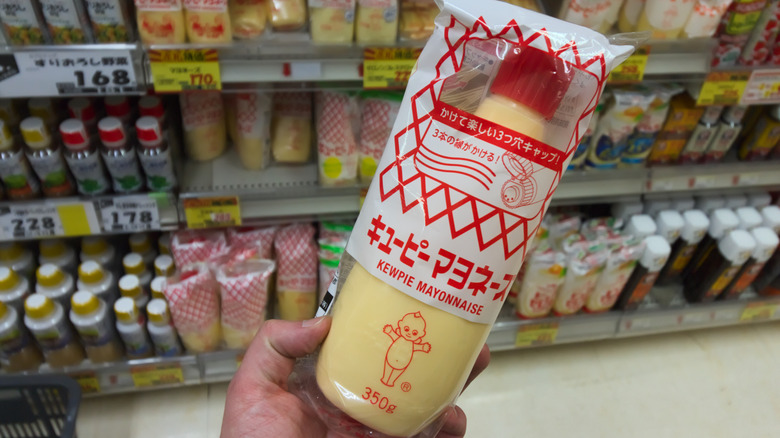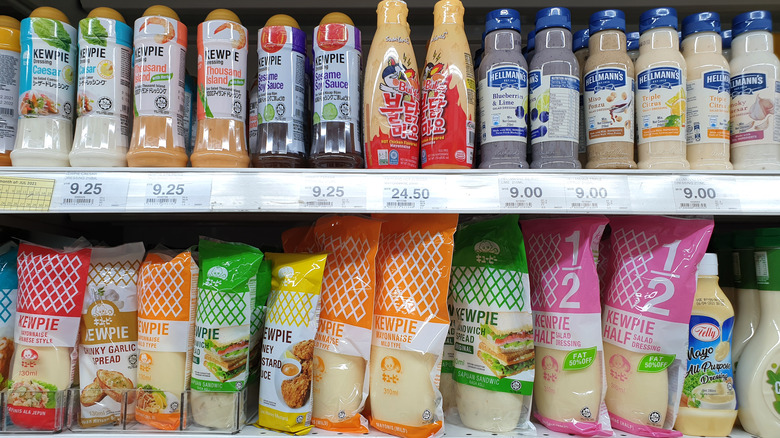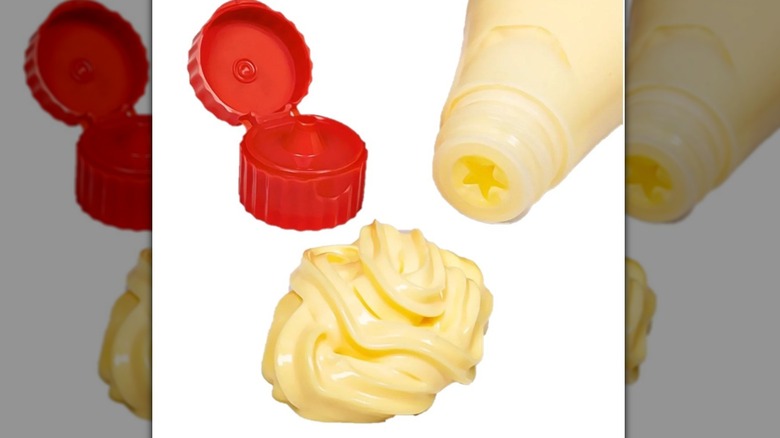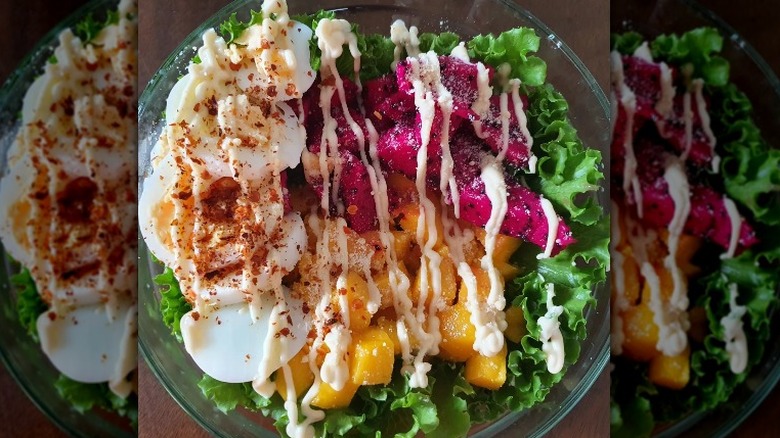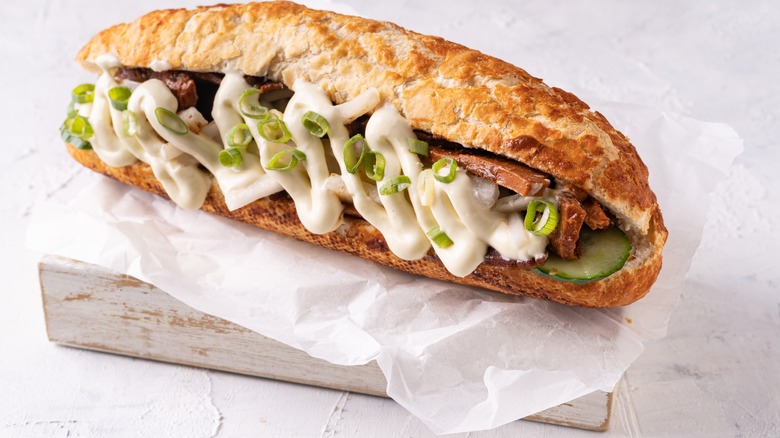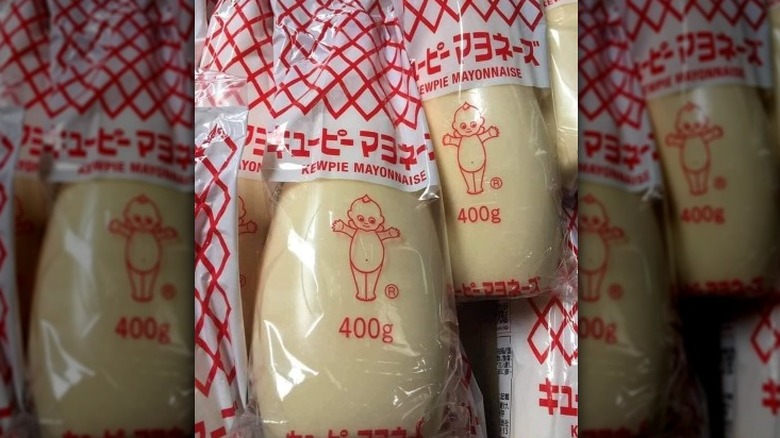Is There A Difference Between Kewpie Mayo And Regular?
We may receive a commission on purchases made from links.
If you've ever been to Japan, or are just a Japanese food aficionado, then you've likely sampled Kewpie mayonnaise, the Japanese-founded-and-manufactured mayonnaise that's been charming diners since 1925 (via the official website). An extra-rich, extra-eggy mayo, Kewpie has become a cult favorite in recent decades, and is now enjoyed by folks all over the world — whether used to crisp a grilled cheese sandwich, dolloped atop a poke bowl, or whisked into a Caesar dressing (via Bon Appétit).
Chefs from Momofuku's David Chang to Primehouse's Dino Tsaknis have sung the condiment's praises (via Food & Wine) — so what makes Kewpie so special? Here's what sets this squeeze-tube spread apart from the stuff in the tub you might be used to.
Kewpie is extra-eggy
If you've ever whisked together a homemade mayo, then you know that this simple condiment usually contains just two main ingredients: whole eggs and a neutral oil such as grapeseed or canola (via Allrecipes). But according to Kewpie's official website, after founder Toichiro Nakashima discovered mayonnaise in the United States and decided to market his own version of the condiment in Japan, he decided to make an extra-rich, extra-eggy version using egg yolks only.
The yolks give Kewpie mayo a darker color and extra richness that lends itself to a variety of dishes — not just sandwiches.
Kewpie uses a blend of vinegars
While many mayonnaise recipes, both homemade and commercial, call for plain old, one-note white vinegar, Kewpie mayo contains a mix of rice, red wine, apple cider, and distilled vinegars, which help cut through the richness of the eggy mayonnaise (via Bon Appétit).
According to Archivos Latinoamericanos de Nutrición (ALAN), the vinegar added to mayo also helps lower the pH of the mixture, helping preserve the condiment at room temperature even though it contains raw egg.
Kewpie contains MSG
You've likely heard that MSG, or monosodium glutamate, in food can be responsible for a number of undesired effects ranging from headaches, to nausea, to numbness. Whatever the origin of this myth, it's been thoroughly debunked, according to the Mayo Clinic, leaving us free to enjoy moderate amounts of this umami-packed seasoning.
Kewpie's not-so-secret ingredient is a big reason why chefs love working with the mayonnaise. As David Chang once told Food & Wine, "[Kewpie is] the best mayonnaise in the world, because it has MSG." (One important thing to note: per Bon Appétit, U.S.-manufactured versions of Kewpie omit this tasty ingredient, so try looking for the Asian-manufactured versions available in some Asian and specialty grocery stores.)
Kewpie comes in a squeeze bottle, not a jar
You're probably used to unscrewing a jar of mayo before swiping the spread across a sandwich, but Kewpie mayonnaise comes packaged in a sleek squeeze bottle that's as much about function as it is about form.
According to the mayo's official website, Kewpie's distinctive squeeze bottle is designed to shut out as much oxygen as possible, keeping the mayonnaise fresh and preventing the oil in it from going rancid. Kewpie bottles also come with either a narrow tip for decorative squeezes, or a star-shaped tip for more generous applications of the rich condiment.
Kewpie offers different formulations for varying regional tastes
If you live in the United States and eat mayonnaise, you likely know that Hellman's, in the blue-capped jar, is the country's top-selling mayo — in fact, it's the number one brand of mayonnaise all over the world, reports Zippia. Curiously, in the U.S., this mayo all-star is marketed as Hellman's on the East Coast and Best Foods on the West Coast, the result of a 1932 merger of two condiment companies (via Insider). But though the mayo jars have different labels, their contents are exactly the same.
Kewpie, meanwhile, manufactures a wide array of mayos whose recipes actually vary according to the local market. As stated on the condiment's website, the brand has "developed various mayonnaise to suit the food culture and taste of each country." Slightly differing formulations of Kewpie are available in China, Thailand, Malaysia, Vietnam, and Indonesia, to name a few — plus the U.S. version that omits MSG for additive-avoidant consumers (via Chicago Tribune).
Kewpie Mayo and American mayo don't taste alike
The extra-eggy Kewpie has a zesty flavor that is much more powerful and distinct than classic mayonnaise. Chef Mari Katsumura of Chicago's Yugen restaurant calls the taste "assertive" compared with American counterparts, reports Salon. Unlike traditional offerings, the flavors are more concentrated because Kewpie's spread does not include water (via Pogogi). Kewpie also contains no sugar. The only sweetness in Kewpie comes from the eggs and vinegar mix, per Food & Wine. Thanks to the added MSG, Kewpie also has an umami savoriness melding with the tangy acidity that is lacking in traditional mayonnaise.
Classically-made mayonnaise does not contain MSG, which is suitable for those allergic to the ingredient. Food & Wine adds that traditional mayo is usually noticeably sweeter than Kewpie due to the inclusion of sugar and artificial flavorings.
Kewpie's American version of the mayonnaise is made without MSG, but a side-by-taste test done by the Chicago Tribune found the Japanese version to be more flavorful, with a briny, umami character the American-made Kewpie lacked.
The texture of Kewpie is unique
Kewpie contains only egg yolks instead of the whole egg, with oil and a combination of vinegar emulsified to a creamy, custard-like spread, reports The Takeout. Kewpie's use of only egg yolks creates this lustrous texture, making the Japanese offering thicker and much silkier than traditional mayonnaise. Food & Wine adds that this consistency and Kewpie's squeeze-bottle packaging allow it to be used straight from the bottle. It also ensures the product will always be smooth and silky without the clumpy, curdled texture sometimes found in American-made mayo jars.
Pogogi says Kewpie does not add water, ensuring the product has a richer, more velvety texture than traditional mayonnaise. Most American brands add water, creating a thinner texture that can coagulate in the jar. The ingredient lists for both Hellman's and Kraft Real Mayo shows the second ingredient in each is water (although Hellman's introduced a new, extra creamy mayonnaise a few years ago with 40% more eggs that customer reviews on their website say is much smoother and creamier).
Neither option is particularly healthy
Kewpie inventor Toichiro Nakashima saw Americans enjoying mayonnaise on vegetable-filled dishes in the 1920s, The Takeout reports. He brought the idea back to Japan, believing the condiment would help increase the vegetables Japanese people included in their diets. Adding the creamy, tangy spread to salads and vegetables made them taste better. Kewpie quickly became a part of the Japanese diet and a staple ingredient in Japanese homes — though neither Kewpie nor traditional mayo be considered a health-conscious flavor enhancer. Food Network shares that all mayonnaise contains saturated fat, which is unhealthy, so mayo fans should enjoy the creamy condiment in moderation.
American-made mayo has a slight edge when comparing nutrition labels. Because Kewpie contains only egg yolks, its cholesterol level is higher than American-made mayo that uses the whole egg, like Hellman's. Kewpie has 25 grams of cholesterol per tablespoon, compared to 5 grams in Hellman's. Both brands are high in fat per serving, 10 grams in one tablespoon, each with 1.5 grams of saturated fat. Each has 100 calories per tablespoon.
If you are concerned with sugar in your food, Kewpie is the better option, as the Japanese product contains no sugar. (American-made mayo includes sugar, though Hellman's labels it as a trace amount.) We do recommend slathering Kewpie mayo on your bread before toasting a grilled cheese instead of butter. One tablespoon of Kewpie has the same calories as butter, and butter weighs in with over 7 grams of saturated fat.
Kewpie mayo is more expensive than regular mayo
The Japanese option is pricey compared to its American counterparts. Depending on where you shop, a small bottle of Kewpie can cost anywhere from $6 to $16! A 30-ounce tub of Hellman's at Target costs less than the 17-ounce bottle of Kewpie. So, American-made mayo is the way to go if you want quantity.
However, Kewpie also has a richer texture than regular mayo as it doesn't include water, giving you a more concentrated flavor, even with less product in the bottle. Kewpie may be ideal if you're the type who uses mayo only on the occasional turkey sandwich or to drizzle over french fries or spicy crab salad sushi. Thanks to Kewpie's squeeze-bottle packaging and resealable cap, the product will last in your fridge for months.
As mentioned before, Kewpie's thick plastic bottle blocks oxygen from entering the bottle when used, extending the shelf life of the product (via Food & Wine). The Fork Bite adds that an open bottle of Kewpie mayo was still good after three months in the fridge, without spoilage. For the best results, though, it's recommended to use the condiment within one to two months after opening the bottle.
